1. Introduction
 Several months ago, ASUS, one of the biggest hardware manufacturers, released an internal 16X Dual Layer Recorder, the 1604P, breaking new ground with 4X DL writing and becoming one of the fastest DL recorders on the market. Not much has changed since then in the DL writing speed limit until today, when ASUS introduces us to its latest release, the 1608P drive, a 16X±R and 6X DL recorder, breaking once again the DL writing speed limit.
Several months ago, ASUS, one of the biggest hardware manufacturers, released an internal 16X Dual Layer Recorder, the 1604P, breaking new ground with 4X DL writing and becoming one of the fastest DL recorders on the market. Not much has changed since then in the DL writing speed limit until today, when ASUS introduces us to its latest release, the 1608P drive, a 16X±R and 6X DL recorder, breaking once again the DL writing speed limit.
- Features
The ASUS 1608P DL recorder, uses the same innovative technologies present in the previous release:
- FlextraLink - No More Disc Coasters
Unusable discs are often caused by buffer under-run, which occurs when the system cannot keep up a steady data stream to the writer, causing "blank spots" on the disc. FlextraLink prevents this problem by marking the disc where writing stopped and resuming the operation at the same place, when information flow begins again.
- FlextraSpeed - The Best Recording Speed
FlextraSpeed intelligently adjusts writing speeds depending on the media. The best operating speed effectively lowers operation noise, prolongs motor life and saves CPU resources.
- DDSSII - Precision for Reading and Writing
DDSS II (Double Dynamic Suspension System II) is a patented anti-vibration technology. It stabilizes the pick-up head vertically and horizontally, achieving more precise tracking while reducing vibration and noise.
- Liquid Crystal Tilt - Precision on uneven discs
LCT (Liquid Crystal Tilt) technology provides enhanced pick up head accuracy during recording and playback on disks with uneven curvature and thickness.
- Specifications
| Model |
ASUS DRW-1608P |
| Write Speed |
DVD+R (DL) |
6X (CLV), 4X, 2.4X |
| DVD-R (DL) |
6X (CLV), 4X, 2X |
| DVD+R |
16X (CAV), 12X (PCAV), 8X, 6X (CLV), 4X, 2.4X |
DVD+RW
|
8X (ZCLV), 6X (CLV), 4X, 2.4X |
| DVD-R |
16X (CAV), 12X (PCAV), 8X, 6X (CLV), 4X, 2X, 1X |
| DVD-RW |
6X (CLV), 4X, 2X, 1X |
| CD-R |
40X (CAV), 32X (PCAV), 16 (CLV), 10X, 4X |
| CD-RW |
24X (ZCVL), 20X, 16X (CLV), 10X, 4X |
| Read Speed |
DVD-ROM |
16X (CAV) |
| CD-ROM |
40X (CAV) |
| Random Access Time |
DVD-ROM |
130 ms |
| CD-ROM |
120 ms |
| Interface |
Enhanced IDE/ATAPI |
| Data Buffer Size |
2MB |
| Application Discs |
DVD Single/Dual layer discs, DVD+R, DVD+RW, DVD-R, DVD-RW, CD-ROM Mode 1, CD-ROM/XA Mode 2, (form 1, form 2), Photo CD (single and multiple session), CD-DA, CD-Extra, Video CD, CD-Text, CD-R, CD-RW, DVD-RAM |
| Write Format |
DVD-R & DVD-R (DL) |
DAO, Incremental Recording (Multi-Border Recording)
|
DVD-RW |
Restricted Overwriting, DAO, Incemental Recording (Multi-Border Recording) |
| DVD+R & DVD+R (DL) |
Sequential Recording (Multi-Session Recording) |
| DVD+RW |
Random Recording |
| CD-R & CD-RW |
DAO, TAO, SAO, Packet Recording (Multi-Session Recording) |
| OS Compatibility |
Windows 98SE/ME/2000/NT/XP |
| Mounting Orientation |
Vertical/Horizontal |
| Temperature |
Operating : + 5°C to 45°C |
| Storage : - 20°C to 60°C |
| Humidity |
Operating : 5% to 85% (non condensing) |
| Storage : 5% to 90% (non condensing) |
| Power Requirement |
DC +5V +/-5% |
DC +12V +/-10% |
| WxHxD |
148 x 42.3 x 180 mm |
| Mass |
1000g |
The drive uses the famous RPCII region control which, for the purposes of this review, was set to region code 2. There is no known way at the moment to set the drive to region free.
Below are the drive's main specs as given by NeroInfoTool. and DVDInfoPro:


- Retail Package

The retail package consists of : the ASUS 1608P internal IDE drive, an IDE cable, mounting screws and audio cable, as well as bundled software (Nero and Ulead DVD movie factory). The package also includes a multilanguage quick installation guide, an emergency eject pin and instruction manual.
-The Drive

On the front of the ASUS drive, we can see the different supported format logos while on the rear we have the analogue audio output, the IDE Master/Slave/CS
selection pins, the IDE interface and the power input.

Below we can see a picture of the drive's identification label, located on the top of the drive which consists of information about the drive's serial number, manufacture date, model number, power supply rating, compliance logos, as well as the rear interface schematic and jumper settings.
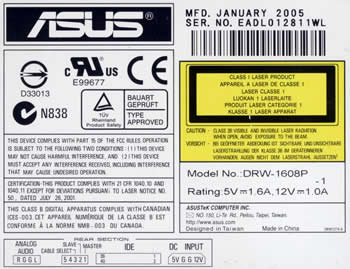
Once again we provide you with images of the drive's circuitry, removing the screws and cover plate. We don't recommend you do this since it will void the warranty. Clicking on the image will result in a higher resolution image of the drive's internal mechanism.
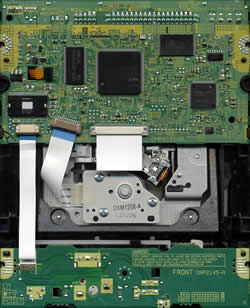
The main chipset are from NEC, the NEC
D63641GM. Same chipset can be found in the Pioneer
DVR-109 burner. You can
follow this
link if you need more information about this chipset.
Below is a close up picture of the drive's pickup, lens system:
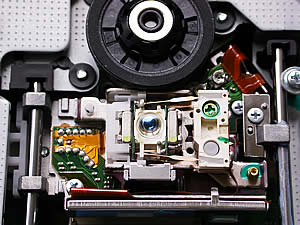
- Installation
The device was connected to our test PC and was identified as "ASUS DRW-1608P" under Windows XP.

-Firmware
The drive came with firmware revision 1.17 installed and was upgraded to the latest 1.50 revision. As is stated by ASUS, "The drive will offer DVD-R Dual Layer compatibility through a firmware upgrade
once the DVD-R Dual Layer specification has been officially approved by the DVD
Forum. The write speed for selected DVD-R Dual Layer and +R Double Layer media
types can also be increased to 6X through this firmware upgrade".
Also, "The +RW Alliance is now finalizing the +RW 8X format and the product can be enhanced to support this media through a firmware upgrade once the +RW 8X specification has been officially approved by the +RW Alliance".
In this review, we will be comparing the drive with the Pioneer DVR-109,
Plextor PX-716A and LG GSA-4163B since all four drives share the same specs regarding speed.
- Testing software
In order to perform our tests we used:
- Nero CD-DVD Speed v3.75
- CDVD Benchmark v1.21
- ExactAudioCopy v0.9 beta5
- Nero Info Tool v3.00
- PlexTools v2.20 (Reader: Plextor PX-712A firmware v1.03, Reading speed 8X CLV for CD-R)
- DVDInfoPro v3.51
- Nero Burning Rom v6.6.0.12
- DVD Decrypter 3.5.4.0
- CopyToDVD 3.0.51.94
2. Transfer Rate Reading Tests
- CD Format

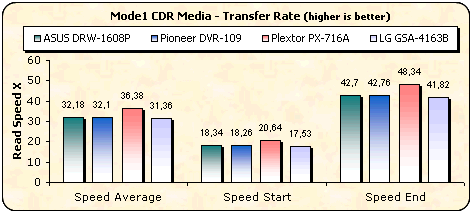
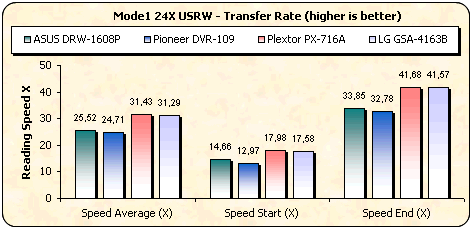
In the first two comparison graphs, we can see that the PX 716 is the fastest in reading both Pressed and CDR media, due to its higher 48X maximum speed support, while the other drives have a max speed of 40X. With USRW media, the Plextor drive was the fastest reader, again due to its higher supported speed of 40X while the ASUS and LG drives support a maximum reading speed of the 32X.
- DVD Format
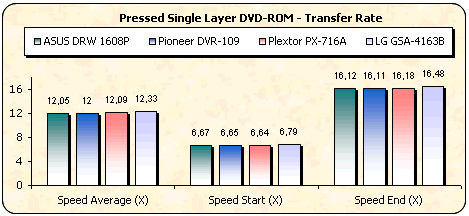
As we can see from the above graph, with SL media, all drives gave similar reading speeds due to the fact that all drives have the same reading strategy and reading speed.
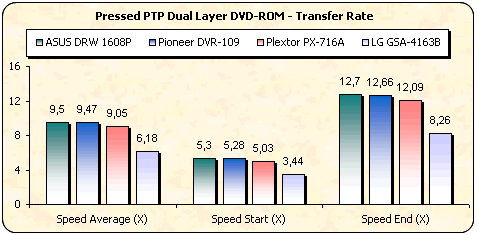
The two layers of a PTP DVD-ROM disc are read sequentially
with the drive starting the reading process from the inner part of the disc, which is the
beginning of each layer, progressing towards the outer range for each layer.
Since the release of the previous ASUS drive, the 1604P, things have improved here and the 1608P manages to not only start at the fastest speed, but has the fastest end speed as well.

The first layer of an OTP dual layer
DVD-ROM is read exactly the same way as the first layer of the PTP disc we
tested previously.
The difference here is the reading strategy of the second layer on the disc.
The beginning of the second layer is located in the outer part of the disc,
so the drive starts reading from the outer tracks progressing toward the inner
part of the disc. Excellent performance from the ASUS drive in this case too.


Very fast reading from the ASUS drive with DVD±R media and second fastest with the DVD±RW discs. The most consistent performer here is the Plextor PX-716A.

In the DVD Ripping test, the drive did not do that well, with less than half the rate of the Plextor drive.
-Appendix
Nero CD-DVD Speed Graphs
3. CD Error Correction Tests
In the following tests we check the drive's behaviour when reading
scratched / defective audio discs. The test discs used were the ABEX series
from ALMEDIO.
- ABEX TCD-721R

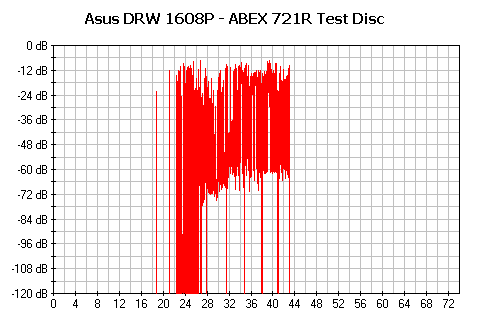
|
Errors
total |
Num:
14541984 |
|
Errors
(Loudness) dB(A) |
Num: 127111 |
Avg:
-44.0 dB(A) |
Max:
-7.2 dB(A) |
|
Error
Muting Samples |
Num: 103848 |
Avg:
61.2 Samples |
Max: 3584 Samples |
|
Skips
Samples |
Num: 1572 |
Avg:
88.7 Samples |
Max:
726 Samples |
| Total Test Result |
45.1 points (of 100.0 maximum) |
The total error count is extremely high while the maximum error loudness at -7.2 dB(A) is also extremely high and could lead to audible clicks. Generally, most drives record levels that will produce the odd spike reaching into the teens. The ASUS drive manages to hover consistently around -12dB and this has led to high muting sample errors and skipped samples. The total test result illustrates the poor performance in this test.
- ABEX TCD-726

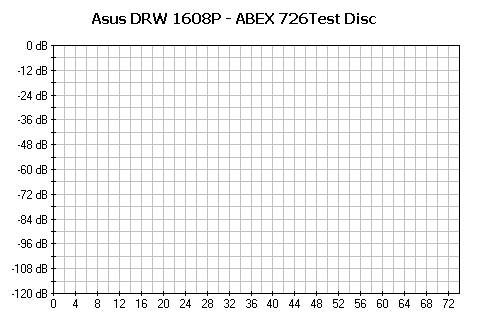
| Errors total |
Num: 0 |
| Errors (Loudness) dB(A) |
Num: 0 |
Avg: -174.0 dB(A) |
Max: -174.0 dB(A) |
| Error Muting Samples |
Num: 0 |
Avg: 0.0 Samples |
Max: 0 Samples |
| Skips Samples |
Num: 0 |
Avg: 0.0 Samples |
Max: 0 Samples |
| Total Test Result |
100.0 points (of 100.0 maximum) |
The Abex TCD-726 test disc is much easier for drives in general to read. The ASUS DRW-1608P drive managed a score of 100.0 out of 100, which is excellent.
- CD-Check Audio Test Disc
 The CD-Check Test Disc is a very useful tool for evaluating the Sound Reproduction
/ Error correction capabilities of a CD player. The disc offers a signal combination
with disc error patterns to rate the drive's abilities to read music and reproduce
it completely. Five tracks on the disc contain a sequence of progressively
more difficult tests. These tracks are referred to as Check Level-1 through
Check Level-5.
The CD-Check Test Disc is a very useful tool for evaluating the Sound Reproduction
/ Error correction capabilities of a CD player. The disc offers a signal combination
with disc error patterns to rate the drive's abilities to read music and reproduce
it completely. Five tracks on the disc contain a sequence of progressively
more difficult tests. These tracks are referred to as Check Level-1 through
Check Level-5.
The
tracks are being reproduced through a software multimedia player (i.e.
Windows Media Player). Each level is considered as passed, if the tone
is smooth, continuous without interruptions, skipping or looping. The higher
the Check Level passed, the more reliable the sound reproduction
of the tested drive.
| Error Level |
1 |
2 |
3 |
4 |
5 |
|
ASUS |
5/5 |
5/5 |
5/5 |
5/5 |
5/5 |
These are the best results we have ever had from a drive with the Audio Test Disk, since not many drives manage to reproduce successfully the fifth track. Great performance.
4. DVD Error Correction Tests
In the following tests we examined the DVD reading capabilities of the drive with scratched / defective DVD media. For the tests we used CDVD Benchmark and Nero CDSpeed. The reference test media comes from ALMEDIO.
- Single Layer media
ABEX TDR-821
This is a single sided, single layer DVD-ROM with a 4.7GB capacity and its surface has an artificial scratch of dimensions varying from 0.4 to 3.0 mm.

The following transfer rate picture comes from the CDVD Benchmark v1.21 transfer rate test.
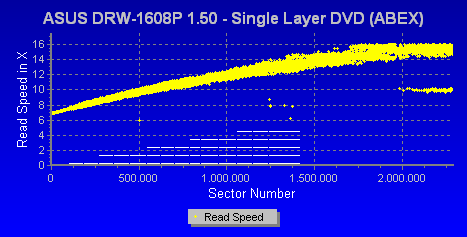
What we have here is an error free test, while the drive managed to reach a speed of 16X at end of the test.
ABEX TDR-825
This is also a single sided, single layer DVD-ROM of a 4.7GB
capacity. The data structure of the disc is exactly the same as that of the
TDR-821, with the difference that there are no scratches on it but instead
defective areas of dimensions ranging from 0.5 to 1.1 mm.

There are also fingerprints sized between 65 and 75 micrometers.
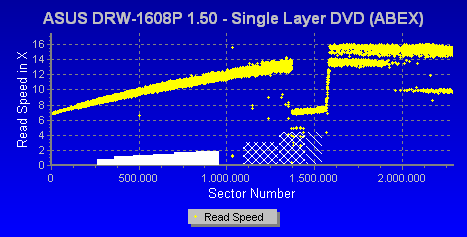
The drive read the first defective area successfully without any significant drop in speed, while towards the end of the second defective area, it dropped its reading speed in order to succesfully read the disc's contents. Once it cleared the defective region, the speed then went back up to 16X.
- Dual Layer media
ABEX TDR-841
This is an 8.5GB dual layer, single sided DVD-ROM disc with artificial scratches
of dimensions ranging from 0.4 to 3.0mm, on both layers.
. 
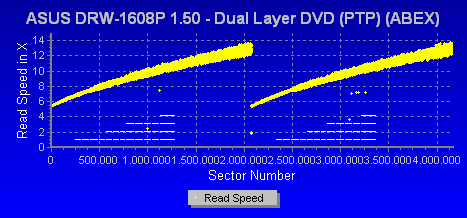
Excellent performance in this case, notice the smoothness in the reading lines with no major fluctuations in reading speed.
ABEX TDR-845
The disc is a single sided, dual layer DVD-ROM disc of a capacity of 8.5GB. The only difference between the TDR-845 and the TDR-841 is that the first includes defective areas and fingerprints.

The dimensions of the defective areas range from 0.5 to 1.1 mm and the fingerprints are sized from 65 to 75 micro meters.

The ASUS drive slowed its reading speed when reading over the fingerprint defects in
Layer0
but didn't slow down when reading the corresponding area in Layer 1. This is the same behaviour as we had seen with the previous ASUS DRW-1604P model.
ABEX TDV-541
The TDV-541 is a single sided, dual layer DVD-VIDEO disc, with a capacity of 8.5GB.The disc is based upon the TDV-540 series which is designed for inspection and adjustment of DVD-VIDEO players. The discs check the layer switch operation from layer 0 to layer 1 and also include test pictures and test signals for DVD sound files.

The current TDV-541 also checks the error correcting capabilities of
the drive and includes scratches from 0.4 to 3.0 mm.

While the drive completed the first layer without any errors, in the second layer, in order to succesfully read the whole disc, it dropped it's reading speed. Nevertheless, the reading of the defective disc was successfull. Again, we should mention that the previous DRW-1604P model also had problems with the second layer and in fact was unable to complete the test.
ABEX TDV-545
The TDV-545 disc is based on the TDV-540 series. It is a single sided, dual layer DVD-VIDEO disc with a capacity of 8.5GB.

The TDV-545 includes artificial black dots on the data surface, sized from 0.4 to 1.0 mm. It has also 65 - 75 micro meter fingerprints.
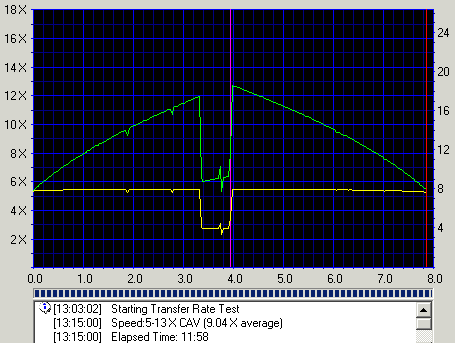
Could have been an excellent reading, if not for the drop in speed near the layer change in the first layer. Eventually, reading was completed succesfully.
5. Protected Disc Tests
- Reading Tests
To create the image of the various protected titles to the hard disk, we used Alcohol 120% software and the appropriate settings, according to the protection type of the inserted discs. Below you can see the duration of each process as well as the transfer rate in each case.
| Game Title |
Protection Scheme |
Duration |
Reading speed |
| PSX "NBA Jam Extreme" |
Lybcrypt |
3:50 min |
393 sectors/sec |
| Serious Sam The Second Encounter v1.07 |
SafeDisc v.2.60.052 |
55.28 min |
101 sectors/sec |
| VRally II |
SecuROM v.2 |
2:32 min |
2262 sectors/sec |



The ASUS drive only performed well when ripping the Securom2 protected
disc to the HDD. The drive is extremily slow with Safedisc2 and PSX discs.
- Writing Tests
The drive supports the DAO-RAW writing mode. For checking the drive's EFM correction status, we used 5 different game titles with different SafeDisc 2 versions having the latest software patches installed. After making the images of the various titles onto the hard disk, we burned them (maximum speed) with Alcohol 120% v1.9.2.1705. Two different discs were created for each title; one with the "Bypass EFM error" enabled and one more with the function disabled.
- Fifa 2004 - Safe Disc v3.1x
- The Sims Superstar - Safe Disc v2.9x
- The Sims Unleashed - Safe Disc v2.8x
- Serious Sam Second Encounter - Safe Disc v2.51.021
- Max Payne - Safe Disc v2.51.020
The table below shows the results of the attempted backups and whether they worked (game installed / played normally), or not.
| Drive |
Fifa 2004
SD v3.1 |
Sims Superstar SD v2.9 |
Sims Unleashed SD v2.8 |
Serious Sam-Second Encounter
SD v2.51.051 |
Max Payne
SD v2.51.020 |
| EFM OFF |
EFM ON |
EFM OFF |
EFM ON |
EFM OFF |
EFM ON |
EFM OFF |
EFM ON |
EFM OFF |
EFM ON |
Toshiba
SD-M1502 |
No |
Yes |
| Creative CD5233E |
ASUS DRW-1608P |
The drive can only accurately backup up to SD v2.51.201. Newer versions
of SafeDisc 2 cannot be accurately backed up, either with the EFM Correction
option
enabled or disabled.
6. DAE Tests
- Pressed and CDR AudioCD results
The drive supports up to 40X CAV DAE speed. The following results were reported when using Exact Audio Copy.
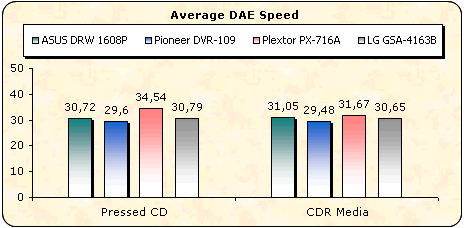
Consistent speed from ASUS drive at around 31X with both Pressed and CDR media.
- Advanced DAE Quality


All tested drives recorded a perfect quality score of 100. The ASUS drive's
average reported speed was 29.06X. Looking over the advanced features, we can see that the drive can read CD Text and Subchannel Data, but can not read the lead in and lead out area.
- Ripping 90min AudioCDs
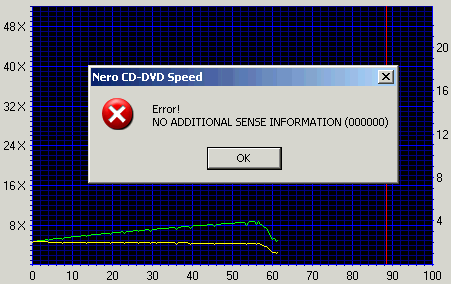
The drive could not read the 90min audio CD succesdully, reporting the above error...
-Ripping 99min AudioCDs
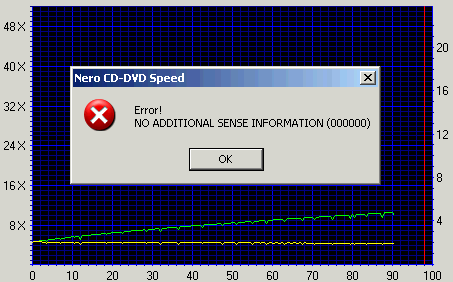
Same case with the 99min audio CD...
7. Protected AudioCDs
For the test procedure we used three audio discs with different audio copy protections. The ripping process on all protected Audio discs was carried out with Exact Audio Copy v0.9beta5.
The tested protected Audio discs were:
- Sony's Key2Audio from "Celine Dion - New Day Has Come"
- Cactus Data Shield 200 from "Natalie Imbruglia - White Lilies Island"
The Cactus Data Shield 200, contains artificial errors that are not easily bypassed by the reader, while the Key2Audio contains a second session, causing problems for readers when trying to read the Table Of Contents (TOC).
The tested tasks are:
- Recognition of the inserted disc (Yes/No).
- Ripping all wavs (with EAC's Burst Mode) to the hard disk with copy&compare function.
- Listening to the produced wavs for any click/skips.
The ASUS drive recognized up to the 12th Audio track of the CDS200 disc,

and with the "Retrieve Native TOC" option removed, the 13th Data
track was also recognized.

The test results are shown in the following table:
| ASUS DRW-1608P |
Key2Audio |
CDS200 |
| Ripping process completed, EAC reports no problems, Read&Test CRC comparison not the same for corresponding tracks |
Ripping process completed, EAC reports no problems, Read&Test CRC comparison not the same for corresponding tracks |
The drive managed to successfully rip both protected CDs, however the Read&Test CRC comparison wasn't the same for corresponding tracks....
- Cactus Data Shield 200.0.4 - 3.0 build 16a (Aiko Katsukino - The Love Letter)
 This is a "special" CDS200 build, since it doesn't contain any artificial errors during the ripping process. Most problems occur when trying to write the ripped wav files, since the produced CD-R disc contains C2 and CU errors! This "problem" is rumored to be connected to specific chipset weaknesses.
This is a "special" CDS200 build, since it doesn't contain any artificial errors during the ripping process. Most problems occur when trying to write the ripped wav files, since the produced CD-R disc contains C2 and CU errors! This "problem" is rumored to be connected to specific chipset weaknesses.
We ripped the disc contents with EAC and burned the wav file produced from the Cactus Data Shield 200.0.4 - 3.0 build 16a disc with the latest Nero version as AudioCD+CD-Text. The burned media was checked for C1/C2 errors and for BETA/Jitter errors with PlexTools software using Plextor PX-712SA (firmware v1.03).
| ASUS DRW-1608P |
CDS 200.0.4 - 3.0 build 16a |
| Reading/Writing performed without any errors |
- C1/C2 Error rate from PleXWriter PX-712SA (8X CLV reading speed)

- BETA/Jitter Error rate from PleXWriter PX-712A

The C1/C2 error graph shows that the drive did not manage to produce
a 100% error free disc.
We then tried to extract all wav files with the Plextor PX-712A and PlexTools DAE Error Correction 5th Level enabled:

No reading errors were reported after extracting all files.
8. CD Recording Tests
- CD-R Format
The drive supports 4X, 10X, 16X (CLV), 24X, 32X (PCAV) and 40X (CAV) writing speeds.
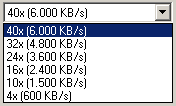
According to Nero CDSpeed, the drive ended the test after 2.59mins. The
test started at 17.79X and finished at 40.66X having an average speed of 30.51X.
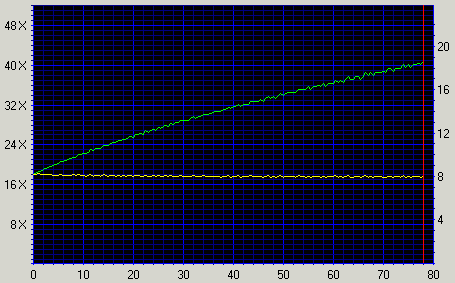
- CD-R Recording Times
We created an 80min data compilation with Nero Burning Rom and recorded
it on a 700MB disc. The writing performance varies depending on the inserted
media. Below is a chart showing all recording times with
various
media.
The best recording time came with Verbatim media at 3:22min.

- Other features
The drive supports overburning, writing up to 90mins and can read/write
CD-Text.
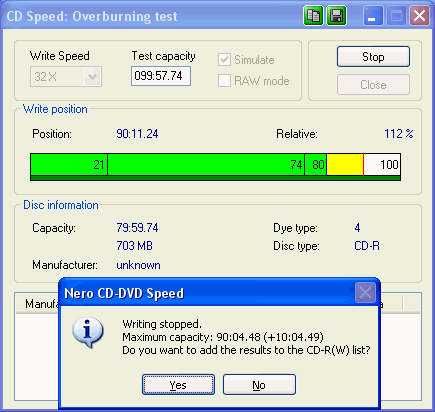
- CD-RW Format
The drive supports both HS-RW and US-RW formats. With US-RW media 10X,
16X (CLV), 20X and 24X (Z-CLV) writing speeds are available, as Nero reports
below.

Below you can see the Nero CD-DVD Speed writing simulation test with blank 24X US-RW media from Mitsubishi Chemicals.
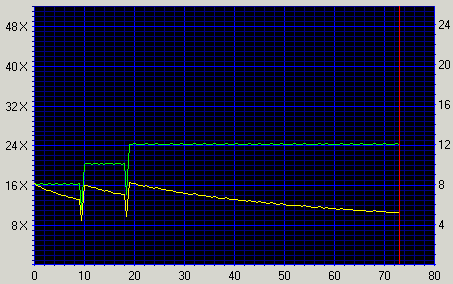
According to Nero, the test ended after 3:44mins, reporting a maximum speed of 24.02X and an average speed of 22.43X.
- CD-RW Mount Rainier
The drive doesn't support the Mount Rainier feature.
9. Writing Quality Tests - Clover System Tests
The Clover Systems CDX Compact Disc Analyzer is a high-speed tool to quantitatively measure the quality of a CD. It will analyze CD-DA, CD-ROM, CD-ROM XA, CD-I, CD-R, Photo-CD, Enhanced CD and CD-RW discs at 4X, 8X, 24X, 32X or 40X speed. It effectively measures disc quality by examining the quantity and severity of CIRC errors generated during playback. It also provides the capability to measure signal parameters related to pit geometry, such as asymmetry and reflectivity. Together, all these bits of information provide a thorough analysis of disc quality. The Clover Systems Analyzers can also perform various format-checking tests on data discs, and do bit-for-bit data comparison on all types of CDs. All tests are carried out at the maximum speed of 40X.
CIRC error correction uses two principles to detect and correct errors. The first is redundancy (extra information is added, which gives an extra chance to read the disc), and the second is interleaving (data is distributed over a relatively large physical area). The CIRC error correction used in CD players uses two stages of error correction, the well known C1 and C2, with de-interleaving of the data between the stages.
The error type E11 means one bad symbol was corrected in the C1 stage. E21means two bad symbols were corrected in the C1 stage. E31 means that there were three or more bad symbols at the C1 stage. This block is uncorrectable at the C1 stage, and is passed to the C2 stage. Respectively, E12 means one bad symbol was corrected in the C2 stage and E22 means two bad symbols were corrected in the C2 stage. E32 means that there were three or more bad symbols in one block at the C2 stage, and therefore this error is not correctable.
BLER (Block Error Rate) is defined as the number of data blocks per second that contain detectable errors, at the input of the C1 decoder. Since this is the most general measurement of the quality of a disc, you will find BLER graphs for all media tested below. If you click on the images you can see a more detailed table, indicating error levels. The Red Book specification (IEC 908) calls for a maximum BLER of 220 per second averaged over ten seconds. Discs with higher BLER are likely to produce uncorrectable errors. Al low BLER shows that the system as a whole is performing well, and the pit geometry is good. However, BLER only tells us how many errors were generated per second, and it does not tell us anything about the severity of those errors.
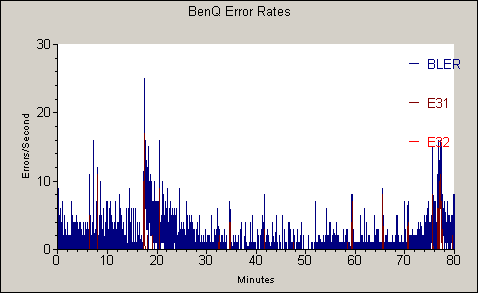
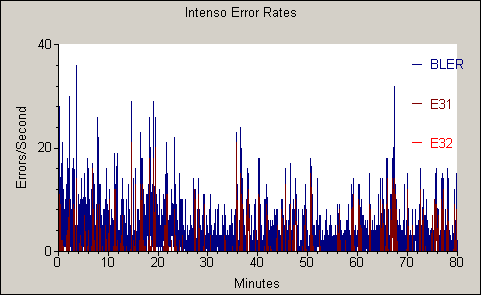



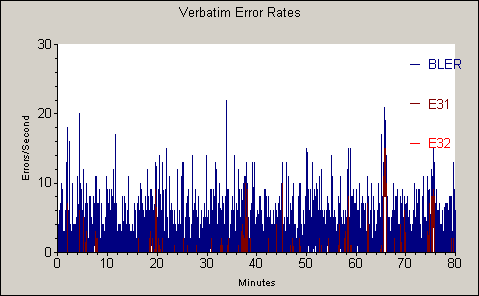
- Summary

Only TY media reported good results, no E32 errors, indicating quality writing. All the rest of the media did not pass the test. Future firmware releases could possibly fix this.
- Appendix
| Media Label |
ID Code |
Manufacturer Name |
Lead Out TIme |
| BenQ 52X |
97m22s67f |
Daxon. |
79m59s74f |
| Intenso 52X |
97m32s19f |
Prodisc |
79m59s71f |
| Ridisc 52X |
97m15s17f |
Ritek Co. |
79m59s70f |
| Traxdata 52X |
97m15s17f |
Ritek Co. |
79m59s70f |
| TY 80min 48X |
97m24s 1f |
Taiyo Yuden |
79m59s72f |
| Verbatim 52X |
97m34s23f |
Mitsubishi Chemical Corporation |
79m59s73f |
10. Writing Quality Tests - C1 / C2 Error Measurements
We measured the C1 / C2 error rate on the recorded discs we burned at the various supported writing speeds. The software we used is PleXTools Professional v2.20, and particularly the built-in Q-Check utility. The reader was the Plextor PX-712SA (firmware v1.05).
BenQ 80min 52X @ 32X

Intenso 80min 52X @ 32X

Ridisc 80min 52X @ 40X

Traxdata 80min 52X @ 32X
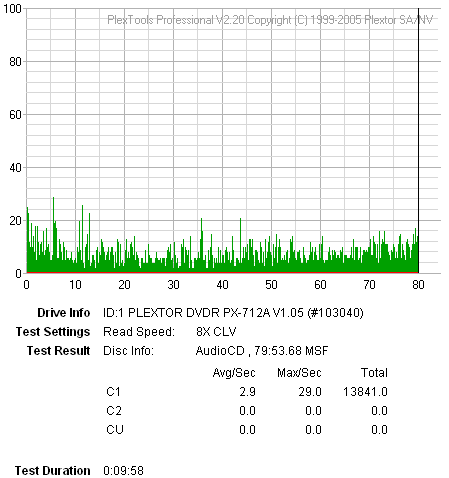
Taiyo Yuden 80min 48X @ 40X

Verbatim 80min 52X @ 40X
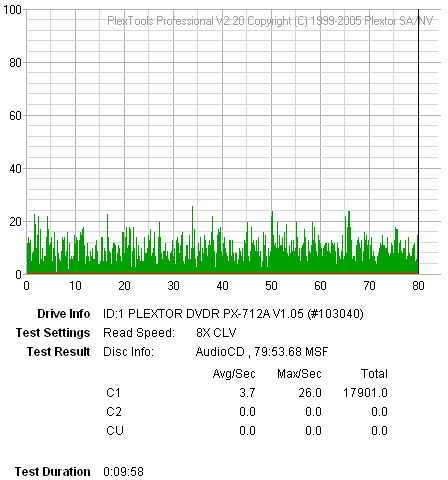
- Summary
Excellent performance with most media, except for Ridisc media which reported levels far beyond the acceptable limit hitting skyhigh at almost 700 near the completion of the reading process. All other media reported extremely low C1 and only Ridisc and Intenso media reported some C2.
- Appendix
| Media Label |
ID Code |
Manufacturer Name |
Lead Out TIme |
| BenQ 52X |
97m22s67f |
Daxon. |
79m59s74f |
| Intenso 52X |
97m32s19f |
Prodisc |
79m59s71f |
| Ridisc 52X |
97m15s17f |
Ritek Co. |
79m59s70f |
| Traxdata 52X |
97m15s17f |
Ritek Co. |
79m59s70f |
| TY 80min 48X |
97m24s 1f |
Taiyo Yuden |
79m59s72f |
| Verbatim 52X |
97m34s23f |
Mitsubishi Chemical Corporation |
79m59s73f |
11. DVD Recording Tests
- Writing Performance
The ASUS DRW-1608P drive supports up to 16X±R (CAV), 8X+RW (ZCLV) with the upcoming firmware upgrade, 6X-RW (CLV) and up to 6X±R DL (CLV).

Now lets have a look at the writing strategies of the reviewed drive.

The ASUS DRW-1604P uses the CAV recording strategy and produced the above graph. Though the graph may seem a little strange, it sure gave some good burns...

The same strategy is used with DVD-R media. In this case we have fewer fluctuations in speed.

At the 12X speed, the drive's writing strategy is Zone-CLV, with three zones (6X->8X->12X). The average writing speed is 9.81X

Again, same strategy, same zones...What catches the eye here is that when using -R media, the graph is smoother. The average writing speed is 10.07X.

The drive's writing strategy with +R media at 8X is Zone-CLV, with an average writing speed of 7.73X

Same strategy, faster writing with -R media..average writing speed is 7.85X. As you can see, the differences are negligeble.

The writing strategy here is CLV, straight smooth graph, all the way to the completion of the writing. Average writing speed is 4.02X. Notice here, that with the DVD+RW media, the drive manages to write the media, at 4X max speed. As stated earlier in this review, 8X burning speed will become available through a firmware revision which will be out soon.

The writing strategy here confirms the 6X writing speed with DVD-RW media, using CLV and with an average speed of 6.03X.
- Burning Tests
We burned 4315MB of data on various DVD±R, DVD±RW media. We used the maximum allowed writing speed for each disc.

Best time was achieved with Maxell 16X DVD-R media, burned at 16X, in 5:54mins. Notice that most 8x media were burned at 12X and as the time indicates, this is not virtual speed, since for example, Maxell 8X media finished in 7:02 which is the average time a 12X disc would take to burn. Worst case senario: 3A media, which is most probably not present in the drives media list.

Writing to DVD+R media at 16X speeds and 8X as well, we can see in the above table that burning times are quite satisfactory, no major ups and downs here. All at normal levels.
- Comparison with other drives


Writing times for DVD±R media, the ASUS drive was slightly behind the Plextor PX-716A. With DVD±RW media, the drive was again a good performer but overall, the Plextor drive had the most consistent performance.
- DVD Overburning Tests
Using Nero CD-DVD Speed, we tested to see if the drive can overburn using DVD+R and DVD-R media. Unfortunately, the drive does not support overburning, giving the following error with all inserted media.
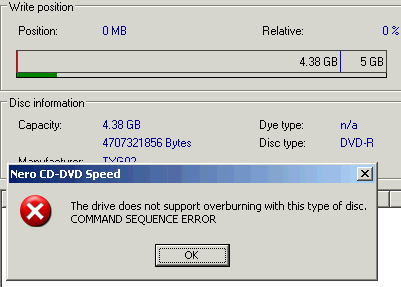

DVD+MRW Tests
The drive doesn't support the Mount Rainier feature
12. CDSpeed/PlexTools Scans - Page 1
In order to test the writing quality and readability of the burned media we used two readers with two software applications:
- The LiteON SOHD-167T with patched firmware being able to read DVD5 up to 16X CAV and DVD9 up to 10X CAV. For the transfer rate tests we used the latest Nero CDSpeed version.
- The Plextor PX-712A with the latest available firmware. For scanning the disc, we used the latest PlexTools version at 2X CLV reading speed, BURST mode, with middle accuracy.
In general, a "perfect" disc should have a smooth reading curve, very low PIE/POE and zero (0) POF error rates. Most times however, even though a disc has very low PIE/POE error rates, the reading curve may not be smooth containing dropoffs. Due to the fact that we oversped the reading capabilities of the LiteON SOHD-167T, such drops are expected, especially near the outer area of the disc.
The measurements below should be taken not as the absolute criteria of the burning quality, but as an indication level.
16X DVD-R Writing Speed



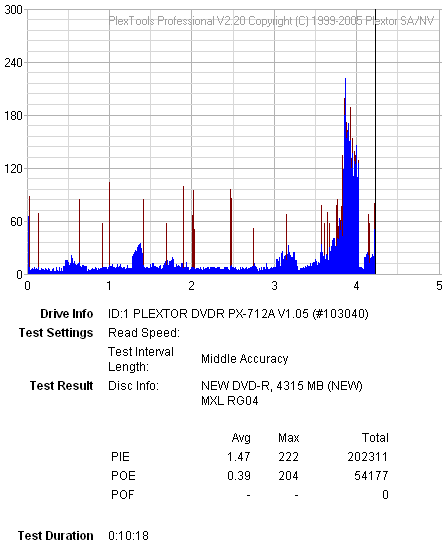








- Summary
Bit of a mixed bag with CMC media producing unrecoverable error and TDK not the straightest of graphs. Other than this, the rest were quite good.
13. CDSpeed/PlexTools Scans - Page 2
In order to test the writing quality and readability of the burned media we used two readers with two software applications:
- The LiteON SOHD-167T with patched firmware being able to read DVD5 up to 16X CAV and DVD9 up to 10X CAV. For the transfer rate tests we used the latest Nero CDSpeed version.
- The Plextor PX-712A with the latest available firmware. For scanning the disc, we used the latest PlexTools version at 2X CLV reading speed, BURST mode, with middle accuracy.
In general, a "perfect" disc should have a smooth reading curve, very low PIE/POE and zero (0) POF error rates. Most times however, even though a disc has very low PIE/POE error rates, the reading curve may not be smooth containing dropoffs. Due to the fact that we oversped the reading capabilities of the LiteON SOHD-167T, such drops are expected, especially near the outer area of the disc.
The measurements below should be taken not as the absolute criteria of the burning quality, but as an indication level.
12X DVD-R Writing Speed
- CMC Magnetics 8X DVD-R @ 12X




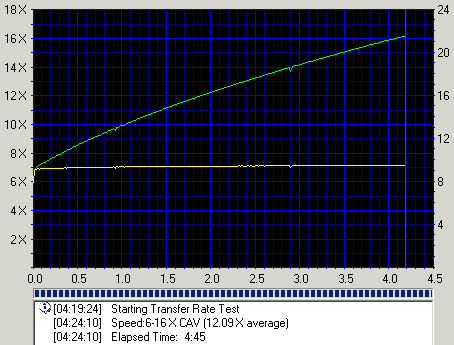







- Summary
High incidence of POE in most cases but generally good results with the being with TY media.
14. CDSpeed/PlexTools Scans - Page 3
In order to test the writing quality and readability of the burned media we used two readers with two software applications:
- The LiteON SOHD-167T with patched firmware being able to read DVD5 up to 16X CAV and DVD9 up to 10X CAV. For the transfer rate tests we used the latest Nero CDSpeed version.
- The Plextor PX-712A with the latest available firmware. For scanning the disc, we used the latest PlexTools version at 2X CLV reading speed, BURST mode, with middle accuracy.
In general, a "perfect" disc should have a smooth reading curve, very low PIE/POE and zero (0) POF error rates. Most times however, even though a disc has very low PIE/POE error rates, the reading curve may not be smooth containing dropoffs. Due to the fact that we oversped the reading capabilities of the LiteON SOHD-167T, such drops are expected, especially near the outer area of the disc.
The measurements below should be taken not as the absolute criteria of the burning quality, but as an indication level.
8X DVD-R Writing Speed



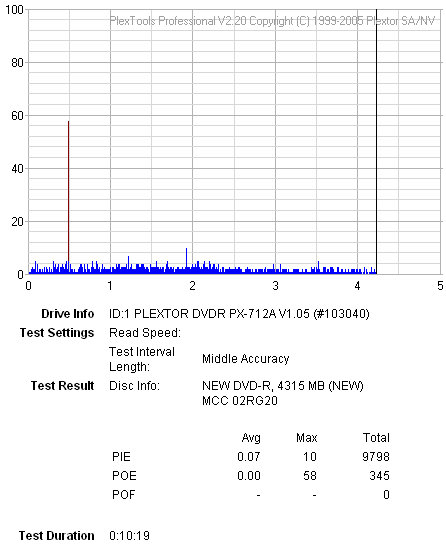
- Summary
Low PIE levels, excellent writing quality.
15. CDSpeed/PlexTools Scans - Page 4
In order to test the writing quality and readability of the burned media we used two readers with two software applications:
- The LiteON SOHD-167T with patched firmware being able to read DVD5 up to 16X CAV and DVD9 up to 10X CAV. For the transfer rate tests we used the latest Nero CDSpeed version.
- The Plextor PX-712A with the latest available firmware. For scanning the disc, we used the latest PlexTools version at 2X CLV reading speed, BURST mode, with middle accuracy.
In general, a "perfect" disc should have a smooth reading curve, very low PIE/POE and zero (0) POF error rates. Most times however, even though a disc has very low PIE/POE error rates, the reading curve may not be smooth containing dropoffs. Due to the fact that we oversped the reading capabilities of the LiteON SOHD-167T, such drops are expected, especially near the outer area of the disc.
The measurements below should be taken not as the absolute criteria of the burning quality, but as an indication level.
16X DVD+R Writing Speed








- Summary
At 16X with DVD+R media, the writing quality does not differ greatly from the general performance so far. Good quality in most cases here too.
16. CDSpeed/PlexTools Scans - Page 5
In order to test the writing quality and readability of the burned media we used two readers with two software applications:
- The LiteON SOHD-167T with patched firmware being able to read DVD5 up to 16X CAV and DVD9 up to 10X CAV. For the transfer rate tests we used the latest Nero CDSpeed version.
- The Plextor PX-712A with the latest available firmware. For scanning the disc, we used the latest PlexTools version at 2X CLV reading speed, BURST mode, with middle accuracy.
In general, a "perfect" disc should have a smooth reading curve, very low PIE/POE and zero (0) POF error rates. Most times however, even though a disc has very low PIE/POE error rates, the reading curve may not be smooth containing dropoffs. Due to the fact that we oversped the reading capabilities of the LiteON SOHD-167T, such drops are expected, especially near the outer area of the disc.
The measurements below should be taken not as the absolute criteria of the burning quality, but as an indication level.
12X DVD+R Writing Speed
- CMC Magnetics 16X DVD+R @ 12X


















- Summary
Once again the quality from the ASUS drive as a burner is very good.
17. CDSpeed/PlexTools Scans - Page 6
In order to test the writing quality and readability of the burned media we used two readers with two software applications:
- The LiteON SOHD-167T with patched firmware being able to read DVD5 up to 16X CAV and DVD9 up to 10X CAV. For the transfer rate tests we used the latest Nero CDSpeed version.
- The Plextor PX-712A with the latest available firmware. For scanning the disc, we used the latest PlexTools version at 2X CLV reading speed, BURST mode, with middle accuracy.
In general, a "perfect" disc should have a smooth reading curve, very low PIE/POE and zero (0) POF error rates. Most times however, even though a disc has very low PIE/POE error rates, the reading curve may not be smooth containing dropoffs. Due to the fact that we oversped the reading capabilities of the LiteON SOHD-167T, such drops are expected, especially near the outer area of the disc.
The measurements below should be taken not as the absolute criteria of the burning quality, but as an indication level.
8X DVD+R Writing Speed










- Summary
The reported error rates are much lower than the limit and the CDSpeed reading graphs as smooth as it gets, in almost all cases.
18. CDSpeed/PlexTools Scans - Page 7
In order to test the writing quality and readability of the burned media we used two readers with two software applications:
- The LiteON SOHD-167T with patched firmware being able to read DVD5 up to 16X CAV and DVD9 up to 10X CAV. For the transfer rate tests we used the latest Nero CDSpeed version.
- The Plextor PX-712A with the latest available firmware. For scanning the disc, we used the latest PlexTools version at 2X CLV reading speed, BURST mode, with middle accuracy.
In general, a "perfect" disc should have a smooth reading curve, very low PIE/POE and zero (0) POF error rates. Most times however, even though a disc has very low PIE/POE error rates, the reading curve may not be smooth containing dropoffs. Due to the fact that we oversped the reading capabilities of the LiteON SOHD-167T, such drops are expected, especially near the outer area of the disc.
The measurements below should be taken not as the absolute criteria of the burning quality, but as an indication level.
DVD±RW Writing Speed

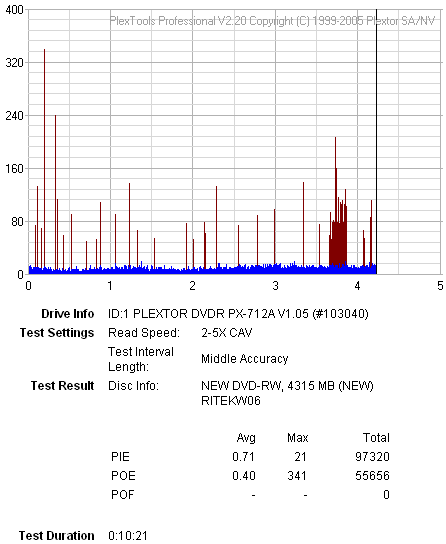

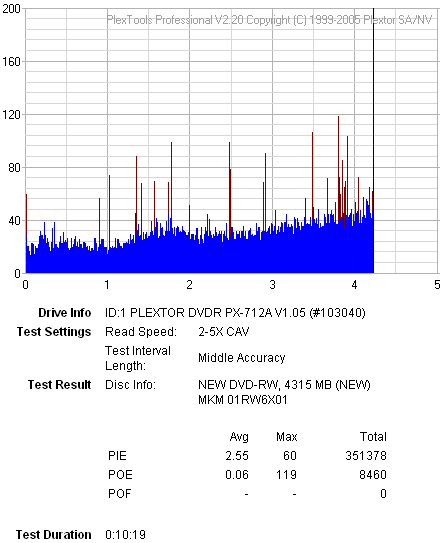




- Summary
DVD-RW recorded at 6X reported very good quality with both Traxdata and Verbatim media. The DVD+RW burning with the ASUS 1608P however needs some improvement.
19. Writing Quality Tests - Almedio AEC-1000
The AEC-1000 consists of a DVD Drive and the "ALChecker" error measurement application which can check the written data quality. The application is capable of 1X CLV measurement as well as 4X CLV on DVD-Video/ROM and finalized DVD+R/-R media.
There are three measurement modes:
- Fine Mode: checks a series of eight consecutive ECC blocks,
- Rough Mode: checks eight consecutive ECC blocks every 100h ECC blocks
- Quick Mode: checks three specified areas
The checking status is shown graphically in real time while you can save the error graph at the end of the test. The reported errors are the PI and the UncPO. In the case of PI, it counts the number of rows corrected by the PI error correction in each group of eight consecutive ECC blocks. In the case of UncPO, it counts the number of ECC blocks in which more than one byte is uncorrectable in eight consecutive ECC blocks. For our quality scans, we set it for 1X CLV and Fine Mode which is the slowest and with the safest results. Also, we chose to measure all the media burned at the maximum available writing speed, namely 16X.





As the above message indicates, the measurement with all four media tested is "good", meaning that all four media are quality burns.
20. DVDR DL - Page 1
The ASUS drive supports both DL formats, +R and -R DL. But unfortunately, the drive couldn't produce a working backup of the Gladiator.Iso which we use in our reviews. But it did manage to succesfully burn at 5.36x average speed, a +R DL media. Lets have a closer look then...
The source disc was "Gladiator Movie - Special Edition" Disc1 with
a total size of 6.86GB. First we transferred the movie to the hard disc with
DVD Decrypter in ISO format (single file).

- Verbatim DVD+R DL 2.4X@6X

The ASUS drive, achieved the "fastest DL burn ever up till now" title, managing to successfully burn a full DL in16:27mins. As we will see from the table at the bottom of this page, this is the fastest time among all known DVD-R DL drives on the market currently.
- Traxdata DVD+R DL 2.4X
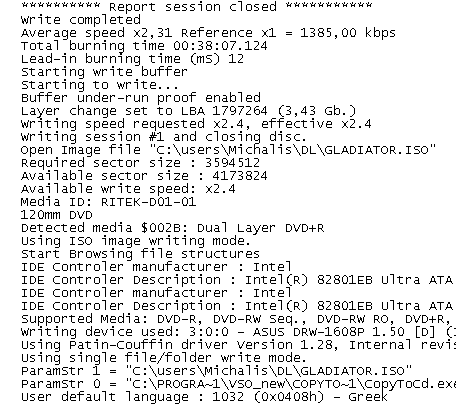
- Ridisc DVD+R DL 2.4X

Lets see what the drive reports, with other media, and with DVD-R DL media in specific.
- Verbatim DVD-R DL 4X@6X

For comparison reasons, we post DL burning results from other writers,
with the same disc content and same recording software. The ASUS drive, stands at the top of the table, being the fastest yet, and the list grows, with the Pioneer 109 being the second fastest.
| Drive |
Time (mins) |
| ASUS 1608P |
16:27 |
| Pioneer DVR-109 (6X) |
16:29 |
| LG GSA-4163B |
22:24 |
| Plextor PX-716A |
23:33 |
| NEC ND-3520A |
22:35 |
| ASUS DRW-1604P |
23:10 |
| Philips DVDR1640P |
24:23 |
| BenQ DW1620A |
24:21 |
21. DVDR DL - Page 2
In order to test the quality of the burned media, we used the Plextor 721A and the LiteOn 1673 drives.
- Verbatim Double Layer media @ 6X

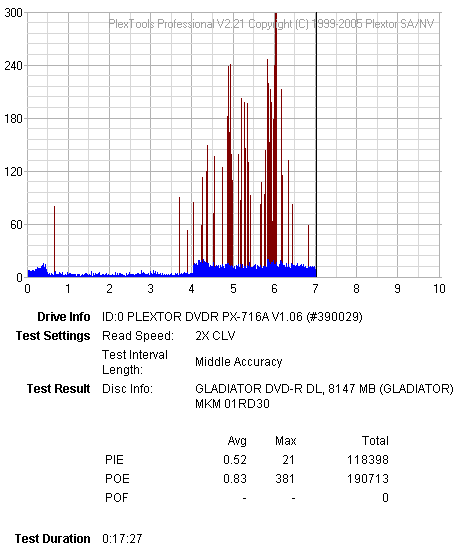
The CD Speed graph is perfect, smooth line, no drops in speed, indicating a good quality burn, while the Plextools scan, reports some POE but extremely low PI. Thumbs up for ASUS 6X capabilities.
- Traxdata Double Layer media @ 2.4X


- Ridisc Double Layer media @ 2.4X


- Verbatim DVD-R DoubleLayer media @ 2.4X


- Summary
Even though the 6X burn went nicely, we can't say this is the case with all other media. Average quality is the headline on this page. Perhaps the future planned firmware upgrade will fix this.
22. 1608P vs SA300
For checking exactly what the ASUS DRW 1608P reports, we used three different media, burned with other writers. The three media have been measured with the well known AudioDev SA300 DVD CATS system at 1X. We used the latest version of CDSpeed, with a special switch to turn this function on. Please note that the posted results are only valid for the specific tested ASUS drive. Using other drives, even another ASUS DRW 1608P can produce totally different results. Be aware!



In the case of PI sum the trend lines are similar but the values are very different. On the other hand, with PIF both trend lines and values are similar.



For sum, the trend lines is the only thing they have in common, while in the PIF graph, there is a small resemblence not only between the trend lines, but to the values too.
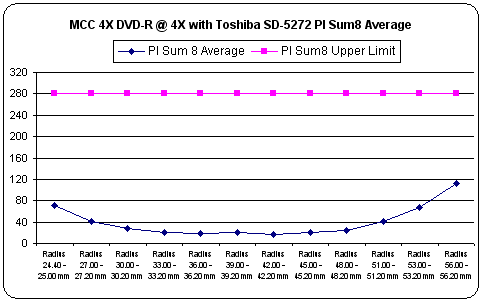
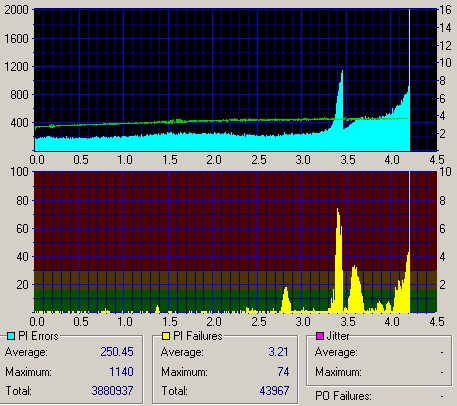
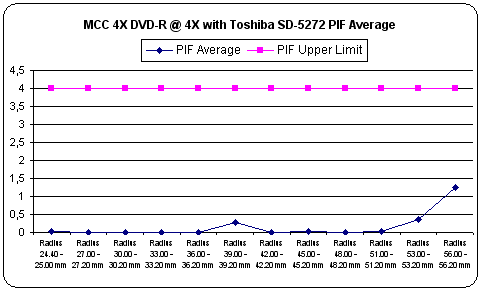
In this case, we have completely different trend lines and values for both PI sum and PIF graphs.
23. Bitsetting
Unfortunately, the ASUS 1608P doesn't support the BookType Setting. Here is a screen of a bitsetting change attempt...
-DVD Info Pro.
We tried to change the booktype setting of 16X DVD+R Philips media...

And we failed to do so. Future firmware upgrades might do the trick.
24. Conclusion
 Some time ago, the Pioneer 109 burst on the scene as the fastest DL writer on the market. Since then, no other drive with 6X DL support has managed to improve on its writing time. Now, ASUS' latest drive, the DRW 1608P has taken over the top spot, improving on this time by two seconds by successfully managing to produce a full DL disc at 6X burning speed in 16:27 mins.
Some time ago, the Pioneer 109 burst on the scene as the fastest DL writer on the market. Since then, no other drive with 6X DL support has managed to improve on its writing time. Now, ASUS' latest drive, the DRW 1608P has taken over the top spot, improving on this time by two seconds by successfully managing to produce a full DL disc at 6X burning speed in 16:27 mins.
Apart form this however, the ASUS DRW 1608P drive has proved a fairly good drive. It may not be a fast CD reader, but it is a very good reader, with extremely good CD error correction, being one of very few drives to read all five tracks of the CD-Check Audio Test Disc. The ABEX TCD-721R test disc provided a few problems for the drive which reported one of the lowest scores for this test. As a DVD reader, the 1608P isn't bad at all. In fact, it's rather good, since it can read any pressed DVD-ROM and any DVD-R media at a very high max speed. The DVD error correction is pretty good too, as the drive carefully determines its reading speed for a complete and successfully read. DVD ripping is not one of the drive's strong points though.
The 1608P is not the drive one might want to use for protected games ripping either, since only SecuROM protected games will be ripped at a fast pace. On the other hand, the three protected audio discs were ripped successfully, no errors whatsoever.
The Advanced DAE Quality test reported a total of 100 points out of 100. 90/99min audio discs could not be read by the drive and reported an error message in both cases. Seems the ASUS drive has an issue with this type of discs, but we hope a firmware upgrade might solve this.
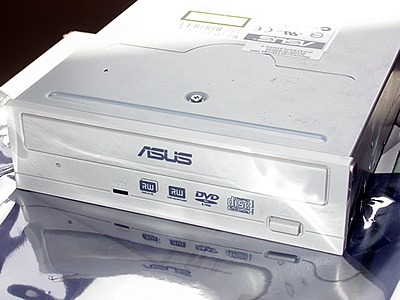
The CD writing speed/quality is one thing that didn't leave us disappointed. The 1608P drive claims 40X writing speed according to its specs, but speed is not so much a problem as the limited supported media list, which forces the drive to write CD media at lower speeds than that certified for. Also, we had somewhat average quality with most media burned excepting TY media. Overburning is also missing, since the drive couldn't recognize our 90/99 test discs where we had limited results, only up to 82mins, using an 80min disc.
In contrast to CD burning speed, the majority of the DVD 8X media, were burned at 12X. Though the burning speed was increased, the quality remained at good levels, although not in all cases, as seen in the previous pages of this review. But we can not say that the drive produced bad quality media. In fact, at 16X, the burned media gave some good result and as for DVD+RW, well, until the next firmware release, we wont be able to see how good the 8X burning speed is since the max burning speed we managed to burn at was 4X. As for DVD-RW, the 6X max speed is supported and with Verbatim media, the drive was able to make a high quality burn.
Concluding, the price for the drive is fairly low, ranging from US$62 to US$68. The ASUS DRW 1608P is certainly an improvement over the 1604P and a very good "companion" for the average user. Advanced users may want something more in a drive, like bitsetting, but this doesn't mean the drive isn't a quality one.
- The Good
- Supports 6X DVD±R DL (8X with future f/w upgrade)
- Supports 6X DVD-RW
- Good DVD error correction
- Good CD error correction
- Supports CD-Text (reading/writing)
- Can read/rip Key2Audio and CDS200 protected discs
- Supports several 8X media at 12X
- Good price
- The Bad
- Cannot accurately backup newest SafeDisk v2 protected titles
- Very slow reader when reading SD2 protected titles
- Doesn't support overburning for DVD±R formats
- Doesn't support DVD-ROM booktype for DVD+R/+RW formats
- Like To be fixed
- DVD+RW writing should be improved
- Bitsetting support.
- Larger media compatibility list
| Retail Package |
 |
| Reading |
 |
| Error Correction |
 |
| Protected Discs |
 |
| Writing |
 |
| Features |
 |
